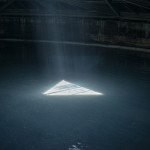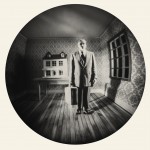Melissa Catanese: Voyagers
Melissa Catanese’s book Voyagers (published by The Ice Plant) has been a constant on my desk this spring. I often read Voyagers as a warm-up, either before reading long form non-fiction or before I begin sequencing my own photographs.
Some days I just leave the book open on my desk to catch an occasional glimpse of the spread that contains the cover image. The juxtaposition that Catanese creates in this spread is as efficient and affective as the infamous match cut in the opening sequence of 2001: A Space Odyssey. Kubrick may cut from bone to satellite, but Catanese cuts from woman reading to shooting star. Both image combinations function simultaneously as montage and as a kind of continuity editing. That said, I find Catanese’s sequence more daring and inspiring. Books too are a form of time and space travel, and the only version of such travel that I want to partake in.
This signature sequence in Voyagers is impactful, yet Catanese has strategically refrained from creating a whole book based on this model. Instead she has embedded such combinations sparingly within a larger typology of snapshots that depict “people in various postures of reading.” This decision makes her juxtapositions all the more powerful when they do appear. Avoiding a predictable sequence allows the reader holding Catanese’ book space to project and to wonder where the depicted readers are “travelling.” And as I found myself constructing theories about the depicted readers, I realized that I had unlocked the meta layer of Voyagers.
Whenever I open Voyagers, I am holding a book in a posture of reading, gazing at other readers. I start to admire the readers and their seeming quietude. I go on to wonder about the identities of the readers, why these pictures were made, and where they came from. I then consider who is being depicted reading and then question why these particular images of readers were collected, preserved, and valued. How and why did these readers survive? My mind roams between formal appreciation, speculation and critical analysis, seamlessly.
The images in Voyagers can certainly be appreciated as a beatific window into the past, but to do so belies the depth of Catanese’s investigation. And while I admire the meta facet of Voyagers, to consider the book solely in the realm of conceptual art does not concede its hopefulness and lyricism. A key aim of Catanese’s practice is to, “build elliptical narratives.” Such an aim implies a high level of intentionality and an invitation to participate, to construct meaning, to read. Voyagers contains a multifaceted call and through reading, I respond again and again.
As a reader I can choose what journeys to go on and how to conduct them. Reading can be an escape from reality, but it can also be an engagement with it; a revelatory practice. Reading can lead to moments of introspection, interconnection, and empathy.
Reading can prompt us to reconsider the past and present, and to contribute to a new future. Such voyages should be sought after and cherished, continually.
Voyagers
Where do our minds go when we read books, magazines, and letters? Do we seek an
escape, a portal to another world? A secret, a truth, a pleasant distraction? My recent
artist’s book, Voyagers consists almost entirely of anonymous black & white snapshots of people in various postures of reading — in living rooms, on beds, at the beach, eating
breakfast. We can’t see what these readers are thinking, but the occasional breaks in the hypnotic typological rhythm reveal a new photographic element — a pyramid, a starry night, sunlight glowing through a window — giving us brief glimpses of the readers’ potential narrative journeys. A wordless book with the size and feel of a vintage paperback found at a flea market, Voyagers reminds us of the power and intimacy of our relationship to ‘reading devices,’ and evokes an exotic nostalgia for our recent pre-digital culture. As with my prior books, the images were judiciously selected from the collection of Peter J. Cohen, a celebrated trove of more than 60,000 vernacular photographs from the early- to mid-twentieth century. – Melissa Catanese
Melissa Catanese works from an inventory of photographic images, both personal and
anonymous, to build elliptical narratives that take their shape as artist’s books and wall
installations. She has worked from the vast photography collection of Peter J. Cohen, a
celebrated trove of more than 60,000 vernacular and found anonymous photographs
from the early to mid-twentieth century. Enfolding photographs from her archive with
found images, she questions the authorship and transparency of a photograph while
pursuing readings that drift away from simple typology into something more personal,
intuitive and openly poetic. She is the author of Dive Dark Dream Slow (2012),
Dangerous Women (2013), Hells Hollow Fallen Monarch (2015), and Voyagers (2018).
Her work has been included in the Mulhouse Biennial of Photography, No Found Photo
Fair in Paris, and at venues such as Pier 24 Photography in San Francisco, Aperture
Foundation in New York, and Cleveland Museum of Art. She has been awarded grants
from BNY Mellon, Greater Pittsburgh Arts Council, and Pennsylvania Council on the
Arts and has taught at institutions including University of Texas Austin, University of
Hartford, Ithaca College, Point Park University and University of Pittsburgh. She is the
founder of Spaces Corners, an artist-run photography bookshop and project space
located in Pittsburgh, Pennsylvania.
Social media handle:
@melissa_catanese
Posts on Lenscratch may not be reproduced without the permission of the Lenscratch staff and the photographer.
Recommended
-
The 2024 Lenscratch 3rd Place Student Prize Winner: Mehrdad MirzaieJuly 24th, 2024
-
One Year Later: Nykelle DeVivoJuly 19th, 2024
-
One Year Later: Anna RottyJuly 18th, 2024
-
The Paula Riff Award: Minwoo LeeJuly 17th, 2024
-
Anastasia Sierra and Carrie Usmar: Talking MotherhoodJuly 16th, 2024












































































